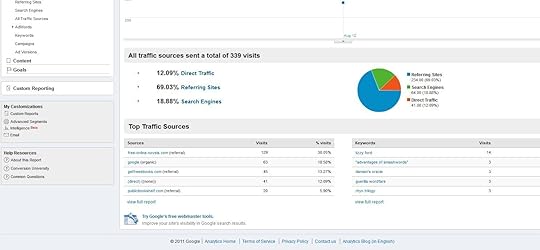Building Your Web Presence for Authors: Google Analytics
There are topics which I would rather write about, but I would be remiss not to discuss tracking and Google analytics first. It's free and a powerful tool for helping you determine where you need to expend your efforts in your online activities to increase traffic to your website. If you're already using Google analytics (or another tracking option) hopefully you learn at least one new thing. If you're not using Google analytics, this should be the first thing you do with your website.
Google analytics is a free service Google provides which automatically tracks everyone who visits your site, where they came from (this is huge), where they go on your site, if they're a new visitor or not etc. If you're serious about building your web presence and brand as an author, you should have a website and you should know: how many people are visiting, what's bringing them there, and what pages interested them the most. The purpose of knowing these things is so you can target and maximize your online activities. Downloading Google analytics is on you, but Google will handle the rest for you free of charge!
Below is a screen shot of our Google analytic page for August 12, 2011
From the information on the main page (not shown) I know we had 339 visits that day from 305 different people. 65% of them were new visitors (woo hoo!)
For the information on this page, I can see that 12% of my visitors are "Direct Traffic". That means one of the following: they typed www.guerrillawordfare.com themselves, they had already bookmarked our page and just clicked on it, or they clicked on a link in non web page (word doc, pdf etc.).
Almost 19% came from search engines. If you look in the lower right, you can see what terms people typed into Google which led them to our page. The most popular was "Lizzy Ford" which brought 14 visits to our site that day.
The remaining 69% of traffic came from referring sites such as free-online-novels.com, publicbookshelf.com etc.
Even without mentioning the thousands of things we can and will do with this data, I'm sure you see the value in knowing who visits you, so you can learn how to be effective in targeting and drawing people to your online brand.
How to obtain and install Google analytics:
1. The first thing you need to do is signup for Google analytics at http://www.google.com/analytics/
This is 100% free of charge.
2. Verify with Google that you own the site. When you sign up for Google analytics, it provides you a tiny snippet of computer code, which you copy and paste within the source code on the main page of your website just before the tag at the top of your html page.
If you or a web designer made your website using html (like Julia's) this step was easy.
If you're one of the millions who uses WordPress, it's almost as easy. Go into your dashboard, click "appearance," then click "editor." This should show the code of one file, and a list of other files on the right hand side. Click on the file called "header" and it should show you the code for that section. First, do both of us a HUGE favor and copy and paste the contents of this file into a text file so you have a backup. Modifying code without having a backup copy is begging for a frustrating night trying to fix your site. Anyways, once you've backed up, you should see a tag in the mid to lower part of the page. Copy the code snippet you got from Google right BEFORE the part being careful not to touch or copy over anything else. Hit update, slowly back away, then go view your website and be pleasantly surprised that you didn't break it.
Once the code is in place, return to your Google analytics account to verify. Google will walk you through the verification process and will do a check, sees the code it sent you is on the site, and therefore trusts that the site is yours.
3. Once you've got your account and Google has verified it, you can move to the next step. The first thing you have to do is once again get another tiny snippet of code from Google analytics. This code is the code which tracks who uses your site and how they use it. This code will go on EVERY page of your website so that Google can track them all. This sounds like a future time sink, it's not. If you use WordPress, there are free plugins which handle putting the code on each page for you (we use one called Google Analyticator). You put your code in the setting for that plugin and never think about it again.
If you use a traditional website like Julia's, all you need to do is add the tiny bit of code in the header of every page you have, and then add it into your template so you never have to worry about this again. The tracking code will go in the same place your verification code went. If you have any problems with this step, there is an active community at http://www.google.com/support/googleanalytics/ .
If you made your own site, this should go smoothly. If you had nothing to do with building your website and don't know source code from a ham sandwich, you can either have the person who made your site add in these code snippets or make your most tech savvy friend dinner in exchange for their labor. Once it's done checking your numbers will become as much a part of your morning routine as brushing your teeth!



